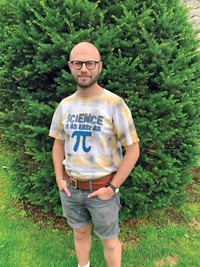Advertisement
Grab your lab coat. Let's get started
Welcome!
Welcome!
Create an account below to get 6 C&EN articles per month, receive newsletters and more - all free.
It seems this is your first time logging in online. Please enter the following information to continue.
As an ACS member you automatically get access to this site. All we need is few more details to create your reading experience.
Not you? Sign in with a different account.
Not you? Sign in with a different account.
ERROR 1
ERROR 1
ERROR 2
ERROR 2
ERROR 2
ERROR 2
ERROR 2
Password and Confirm password must match.
If you have an ACS member number, please enter it here so we can link this account to your membership. (optional)
ERROR 2
ACS values your privacy. By submitting your information, you are gaining access to C&EN and subscribing to our weekly newsletter. We use the information you provide to make your reading experience better, and we will never sell your data to third party members.
Food
Newscripts
The chemistry of coffee and a gassy alcohol
by Andrea Widener
August 30, 2019
| A version of this story appeared in
Volume 97, Issue 34
Deep dive into the chemistry of coffee

Christopher H. Hendon’s obsession with coffee started when he was getting his PhD in chemistry at the University of Bath. Back then he was just a normal person who would drink coffee at his favorite café and chat with the baristas, who convinced him to try increasingly exotic brews.
That is, until one day the coffee wasn’t tasting quite right, and the café owners couldn’t figure out why. “We isolated the fact that it was probably the difference in water chemistry,” he remembers. Not long after, Hendon entered the World Barista Championship with a friend from that Bath café. The first year he fiddled with the water chemistry to change the coffee’s flavor profile. The next year they wanted to spice things up with a pinot noir reduction in their signature drink. Alcohol isn’t allowed, so Hendon presented data showing that the alcohol had all burned off. That research wasn’t worth a hill of beans, according to the judges. But that didn’t slow the team down—instead, Hendon replicated the flavor profile of the pinot reduction by combining grape, cranberry, pomegranate, and walnut flavors. That drink won its category in 2015, and the team came in fifth.
Since then, Hendon has continued his caffeinated obsession, entering coffee competitions and speaking about coffee chemistry at international conferences. His research has expanded to look beyond just the chemistry itself to the physics of the perfect way to grind coffee beans (frozen beans grind most evenly, he found).
Hendon’s competitive coffee days have slowed down since he was hired in 2017 as a professor at the University of Oregon, where he works primarily on computational materials chemistry. But he hopes to build an official lab-café where he could train graduate students on coffee chemistry and let baristas prepare for competitions. Given the size of the coffee industry—$225.2 billion in the US in 2015, about 1.6% of the US gross domestic product, according to the National Coffee Association—there is plenty of room for more research, Hendon says.
Plus, the worldwide obsession with coffee makes it “an awesome platform” to teach the public about chemistry. Hendon remembers going to an inorganic chemistry conference in Japan when he stopped into a café with a few colleagues. One of his coffee research publications “had been printed out, and it was one of the reading materials in the café,” he remembers. He showed his colleagues. “See, this is quite important.”
A gassy way to enhance wine

Coffee isn’t the only drink where science is playing a role. The collectors of peculiar patents at the Annals of Improbable Research recently noted some wacky wine-making intellectual property from 2017. In US Patent 9758752, liquor maker Pernod Ricard reports that bubbling the smelly gas hydrogen sulfide through wine (especially sauvignon blanc) can increase the levels of the most potent aroma compounds. Rather than a rotten egg smell, the method actually enhances the level of passion fruit and grapefruit flavors.
But we’ll just have to wait and see if this patent shows up among reading materials at your local bar.
Andrea Widener wrote this week’s column. Please send comments and suggestions to newscripts@acs.org.




Join the conversation
Contact the reporter
Submit a Letter to the Editor for publication
Engage with us on Twitter